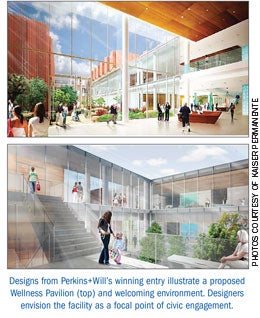Designers lay out big ideas for small hospitals
 Last year, Kaiser Permanente went looking for some big ideas for small facility designs to address sustainability and efficiency beyond carbon neutrality and to restore ecosystems and promote biodiversity. In March, Kaiser Permanente named two winners of the competition it created to spawn fresh thinking for these design challenges.
Last year, Kaiser Permanente went looking for some big ideas for small facility designs to address sustainability and efficiency beyond carbon neutrality and to restore ecosystems and promote biodiversity. In March, Kaiser Permanente named two winners of the competition it created to spawn fresh thinking for these design challenges.
The winning applications from Aditazz, San Bruno, Calif., and the New York City office of Perkins+Will with San Francisco engineered systems consultant Mazzetti Nash Lipsey Burch generated compelling visions for supporting care delivery and efficiency.
Features of the winning applications included intimate patient healing gardens, vibrant public spaces that blended community/retail and health care approaches, and on-site renewable energy systems. Careful attention also was paid to using technologies to promote patient communications.
Designs were judged on factors such as efficiency, including sustainability features; innovation; life-cycle costs; incorporation of methods to improve health outcomes; and flexibility.
Robin Guenther, principal, Perkins+Will, says her organization's entry took the approach that the rural hospital is an important piece of civic architecture.
"We reconceptualized the building as attaching itself to the specialty medical office building, so that a certain group of specialty practitioners call it home and Kaiser members see it as a place to get inpatient and outpatient care, and to come visit friends who are hospitalized," Guenther says.
The Perkins+Will application, one of five submitted by the firm and one of 108 entries submitted by designers, also included such retail functions as a fitness center to make the facility a more vital hub of the community and to promote health. Elsewhere, the design called for an integrated approach to reducing the facility's carbon footprint and promoting sustainability.
Michael Bardin, Perkins+Will senior project designer, says the design team also focused on understanding the flows of water, energy and waste and looked for alternative energy sources.
The on-site wastewater treatment facility called for in the design would begin to filter out pharmaceutical residue of the wastewater.




